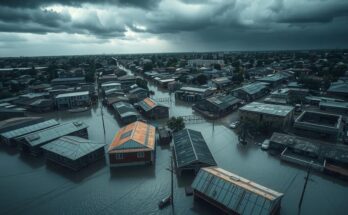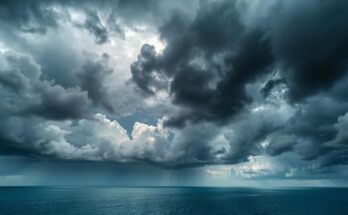A series of potent winter storms is affecting the eastern U.S., with snow, ice, and rain impacting a 1,500-mile stretch. Virginia has declared a state of emergency, while Southern California faces flood risks. As storms progress, travel disruptions, power outages, and severe weather warnings are expected to unfold across numerous states.
A powerful winter storm is currently affecting a significant portion of the eastern United States, stretching over 1,500 miles. This is the first of a series of back-to-back winter storms expected this week. Following this initial storm, another will impact similar regions, delivering potentially record snowfall to Chicago, while Southern California faces a serious flood threat stemming from the storms that have persisted since early February.
As of Tuesday morning, snow accumulation is occurring across the Tennessee Valley and Appalachians, with 1 to 3 inches recorded already. More snow is anticipated by Wednesday morning as the storm progresses eastward. Washington, D.C. could receive up to 6 inches of snow, complicating travel conditions, particularly during the afternoon commute.
Amid the winter weather, Virginia Governor Glenn Youngkin has declared a state of emergency, urging residents to avoid road travel once the storms arrive. Numerous schools in Virginia and Washington, D.C., have announced closures or early dismissals due to the expected disruption. This pattern of disruption is also observed in parts of Kentucky, North Carolina, Ohio, and Indiana.
The National Weather Service has issued warnings of significant ice accumulation, potentially exceeding 0.25 inches in parts of West Virginia, Virginia, and North Carolina. Such ice could render many roads hazardous and lead to power outages due to downed lines and tree limbs. The ongoing storm is tracking further south than previous storms, affecting regions that had previously escaped major impacts, contributing to a considerable winter total in many locations.
Heavy snow is anticipated in Pennsylvania, New Jersey, and across southern New England, with New York City expecting 1 to 2 inches. Concurrently, southern areas will experience heavy rainfall, prompting flooding risks from Texas to the Carolinas, particularly affecting regions beginning to recover from Hurricane Helene. A level 2 risk of flooding has been established for these areas until Wednesday.
The second winter storm is expected to form in the central United States while the first continues its path. Kansas has already declared a state of disaster as heavy snow, ice, and rain spreads from the Plains into the Midwest and Northeast. By Thursday, snow and ice are expected to blanketing significant parts of the Northeast, coinciding with increased rainfall in southern states, raising the threat of severe storms in Louisiana, Mississippi, and Alabama.
The third storm will bring heavy rain to California beginning Thursday morning, classified as an atmospheric river event. This storm presents an elevated risk of flooding particularly in areas impacted by recent wildfires, as officials work to mitigate hazardous debris flows. Precautionary measures in Los Angeles County include cleaning debris basins and deploying sandbags in fire zones to safeguard storm drains.
This storm system is also anticipated to produce heavy snowfall in the Sierra Nevada and mountainous regions of California. As it moves eastward, the storm is expected to impact the Midwest and Northeast by Saturday, yielding a mix of wintry precipitation and rain further south. Severe thunderstorms may arise, particularly in the southern regions, with recent weather events serving as a somber reminder of potential dangers.
While the current storms work their way across the nation, meteorologists are already eyeing the possibility of another winter storm developing by mid-next week. Winter storm patterns indicate no immediate reprieve from disruptive weather across the United States.
In summary, a series of winter storms is set to sweep across the eastern United States, bringing significant snowfall, ice, and rain. With states like Virginia issuing emergencies and schools closing, travel disruptions are anticipated. Southern California faces flood threats from the storms, and preparations are underway to deal with dangerous conditions. The storms signal ongoing winter weather challenges with more systems potentially on the horizon.
Original Source: www.kten.com




